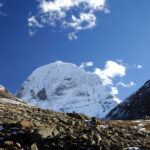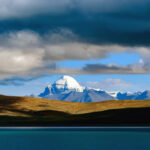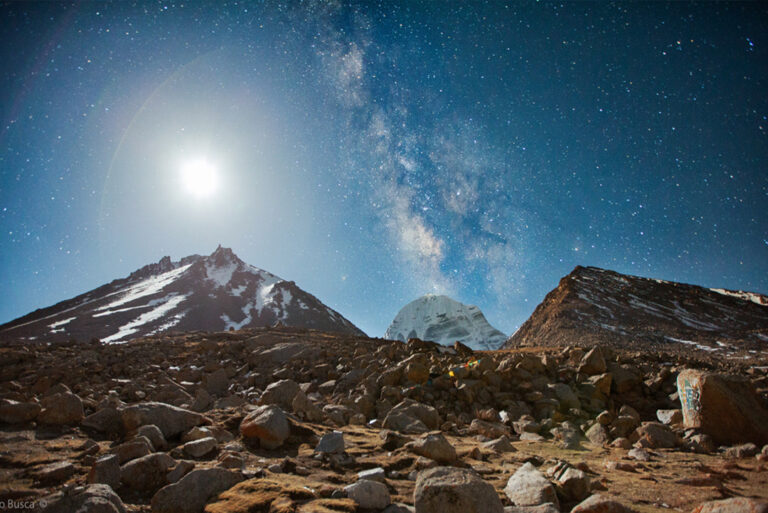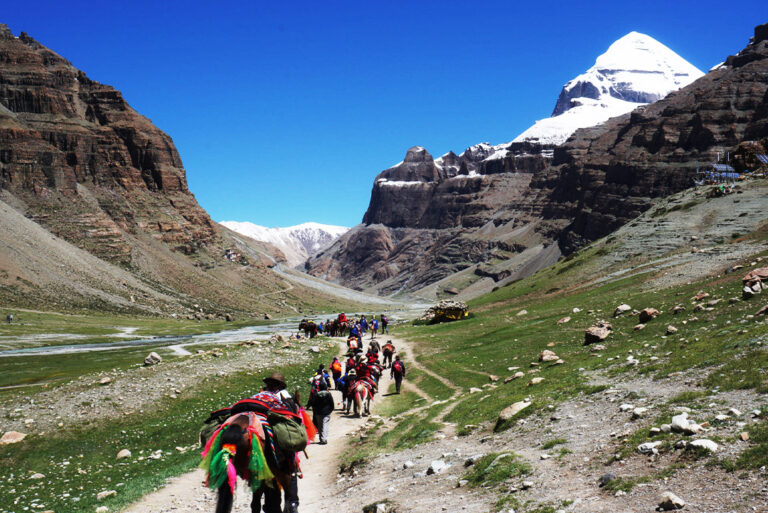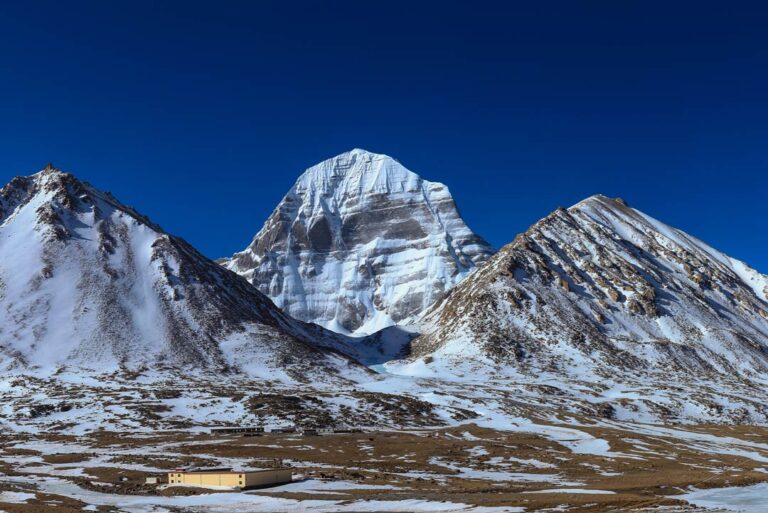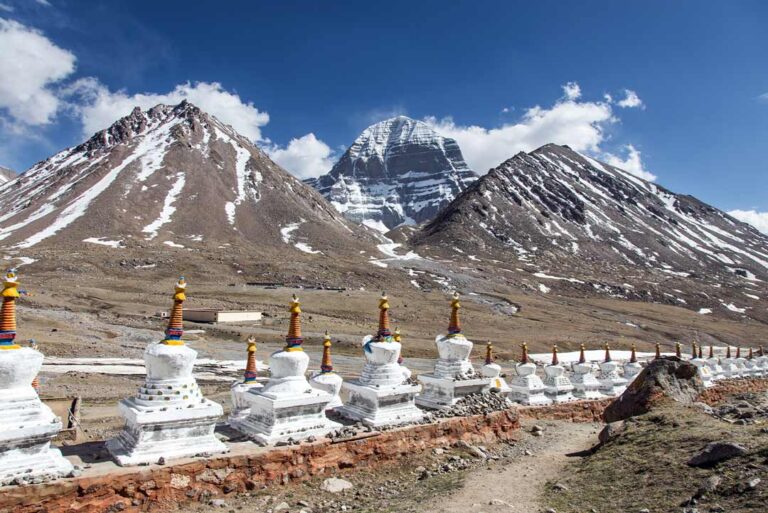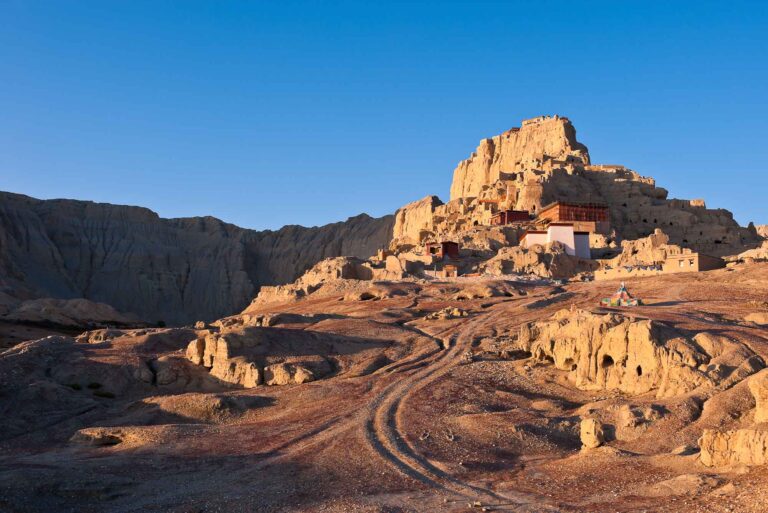Four Faces Of Mt Kailash. Mount Kailash, the majestic abode of faith and spirituality, stands as an embodiment of hope, love, and religious significance, but its significance transcends the boundaries of any one faith or belief system. Located in the heart of the Tibetan plateau, this enigmatic mountain is revered by Hindus, Jains, Buddhists, and the Tibetan Bon Tons, making it a shining example of the shared spiritual heritage that humanity cherishes.
For Hindus, Mount Kailash is the sacred “Abode of Shiva,” believed to be the dwelling place of Lord Shiva himself. It’s where Lord Shiva is said to reside in deep meditation, and where he’s believed to bestow blessings and grace upon his devotees. Pilgrims embark on the arduous journey to seek spiritual awakening and connect with the divine presence that has graced this mountain for centuries.
Jains, on the other hand, revere Mount Kailash as the place where Bhagwan Rishabdev, the first Tirthankara, achieved spiritual enlightenment and attained Nirvana. The mountain holds a profound connection to the Jain faith, and pilgrims visit to pay their respects to this hallowed ground and draw inspiration from the spiritual journey of their revered Tirthankara.
Buddhists also regard Mount Kailash as a sacred site, associating it with Demchog, a deity representing supreme awareness in Tibetan Buddhism. The mountain serves as a spiritual beacon, radiating its energy across the vast Tibetan plateau, attracting Buddhists from all over the world who seek to align themselves with this higher state of consciousness.
The Tibetan Bon Tons, practitioners of the ancient Bon faith, consider Mount Kailash as the “Nine-Story Swastika Mountain,” a place of great spiritual power. For them, it is the axis of the universe, symbolizing the center of the spiritual cosmos. Their rituals and ceremonies performed around Mount Kailash are deeply intertwined with the mystical elements of nature and ancient wisdom.
The reverence for Mount Kailash transcends religious boundaries, making it a pilgrimage destination like no other, where diverse faiths converge and intermingle. It is a place where spirituality unites rather than divides, and where the journey to its four faces serves as a testament to the shared human yearning for spiritual awakening, unity with nature, and a profound connection to the divine.
South Face of Mount Kailash
The Southern Gateway to Divine Adventure
As pilgrims prepare to embark on their spiritual journey, they stand before the Yam Dwar, a revered entry point to the mystical world of Mount Kailash. The Yam Dwar, or “Yama Dwar,” represents the southern gateway to this sacred mountain, where the pilgrims’ adventure into the realm of divinity begins. The air is filled with anticipation, and the very aura of this gateway is pregnant with religious fervor. Here, the physical world melds with the spiritual, setting the stage for an unforgettable odyssey.
Rakshastal: The First Glimpse of Divine Majesty
As the pilgrims traverse the path, their footsteps guided by faith, a breathtaking vista unfurls before them. Rakshastal, a pristine lake nestled amidst the serene landscape, presents the first glimpse of Mount Kailash. This is a moment that leaves a profound mark on the hearts of those fortunate enough to witness it. The southern face of Mount Kailash, snow-covered and majestic, emerges into view. Its unique formation resembles a long, sinuous line, akin to a spine, undulating along the mountain’s surface. To Hindu pilgrims, this enigmatic line signifies the very spine of Lord Shiva himself, the divine creator and destroyer of worlds.
The Spine of Lord Shiva: A Sacred Blessing and Symbol of Protection
In the sacred texts of the Vishnu Dharmottara Puran, Lord Shiva is portrayed as a deity with five faces, each representing different aspects of his divine persona. Among these faces, the South Face stands out as the most fearsome and awe-inspiring. Worshiping this aspect of Lord Shiva is believed to bestow a profound blessing upon the devotees, one that extends protection from untimely death and hardships. As pilgrims embark on the Kailash Parvat Parikrama, the circumambulation of Mount Kailash, it is during the first day of this transformative journey that they are graced with the constant presence of this formidable face.
The Southern Face of Mount Kailash is not merely a geographical feature but a symbol of the divine. It stands as a testament to the enduring faith and spirituality that draws pilgrims from diverse corners of the world to undertake the Kailash Mansarovar Yatra. As the journey progresses, the magnificence of Mount Kailash continues to unfold, offering spiritual enlightenment and a profound connection with the divine.
The southern face serves as the initial brushstroke on a canvas of spiritual exploration, and as pilgrims tread onwards, they will encounter even more remarkable facets of this sacred mountain, each enriching their understanding of the spiritual and natural wonders that define Mount Kailash.
West Face of Mount Kailash: Benevolence and Compassion
Yamdwar to Dirapuk: Transition
As pilgrims continue their journey, the transition from the South Face to the West Face of Mount Kailash marks a significant moment. This part of the trek takes approximately 2-3 hours, covering a midway distance on the first day of the Kailash Parvat Parikrama. The landscape begins to shift, and the West Face starts to reveal itself as pilgrims inch closer to this captivating aspect of the sacred mountain.
The Face of Lord Shiva?
What makes this portion of the pilgrimage truly extraordinary is the phenomenon that has intrigued and captivated pilgrims for generations. Devotees, often lovingly referred to as Bhole Bhakts, have reported encountering what appears to be a massive human-like face on the West Face of Mount Kailash. To them, this remarkable visage is believed to be the divine countenance of Lord Shiva, the great Lord of Destruction and Regeneration in Hinduism. The face, etched into the rocky canvas of the mountain, is viewed with awe and reverence, invoking a profound sense of spirituality and devotion. Pilgrims often pause here to offer their prayers and seek blessings, feeling the divine benevolence that seems to radiate from this extraordinary phenomenon.
Made of Ruby: The Gem of Compassion
The West Face of Mount Kailash is not only revered for its spiritual significance but also for the gem that is believed to constitute it. According to local beliefs, this face of the mountain is made of ruby, a precious gem symbolizing compassion, love, and benevolence. The aura of compassion that surrounds this aspect of Mount Kailash is palpable, and pilgrims often experience a deep sense of inner peace and serenity as they approach this remarkable face.
The journey to this side of Mount Kailash represents not only a physical transition but also a spiritual one. It’s a transformative experience that allows pilgrims to connect with their inner selves and explore the profound spirituality that this sacred mountain embodies. As they continue their pilgrimage, the benevolence and compassion of the West Face remain a source of inspiration and solace, reminding them of the deeper meanings of their journey.
North Face of Mount Kailash: The Golden Glow
The Most Iconic View
The North Face of Mount Kailash, a beacon of spiritual significance and natural beauty, stands as the most iconic among the four faces. Its grandeur and ethereal charm have graced countless photographs and publications, cementing its place as a symbol of divinity. As pilgrims embark on their journey to reach Dirapuk, the anticipation of witnessing this spectacular face builds with each step.
Hiking to Dirapuk: A Pilgrim’s Progress
As the pilgrims approach Dirapuk, the North Face of the sacred mountain looms larger and more majestic. The path unfolds before them, revealing the true magnificence of Mount Kailash. The trek towards Charansparsh is a spiritual journey, a pilgrimage of the heart, and as they draw closer, the aura of the North Face intensifies.
The Golden Touch: A Radiance of Majesty
What truly sets the North Face apart is the mesmerizing play of light. When the sun’s radiant rays caress the surface of Mount Kailash, a breathtaking transformation occurs. The mountain appears to turn to gold, earning it the title of “Golden Kailash.” This transformation, where the peaks and valleys shimmer with a majestic golden hue, adds to the mystical allure of this sacred place.
Made of Gold: A Glimpse into Divinity
According to ancient beliefs, the North Face of Mount Kailash is believed to be made of gold. This attribution to the precious metal only enhances its symbolism of grandeur and divinity. The sharp and crisp features of the North Face evoke a sense of awe and reverence, making it one of the most surreal and unforgettable sights of the entire pilgrimage.
Standing before the Golden Kailash, pilgrims are not only witnesses to a remarkable natural spectacle but are also touched by the profound spirituality that emanates from this face. It is a moment of introspection and spiritual connection that remains etched in the hearts and memories of those fortunate enough to have undertaken the Kailash Mansarovar Yatra. The journey to the North Face is not just a physical endeavor; it’s a transformative experience that embodies the very essence of the pilgrimage, making it an integral part of the spiritual voyage.
East Face of Mount Kailash: A Glimpse from Afar
As you continue your sacred journey around Mount Kailash, the East Face of the mountain holds a special place in the hearts of pilgrims. It remains somewhat elusive, visible only from afar, but its enigmatic nature adds an extra layer of intrigue to the pilgrimage.
Inner Parikrama of Mount Kailash: A Spiritual Exploration
The Inner Parikrama of Mount Kailash is a profound part of the pilgrimage, where you draw closer to the spiritual heart of the sacred mountain. It is during this segment of the journey that the East Face of Mount Kailash becomes visible.
Pilgrims often describe the experience as awe-inspiring. The sight of the East Face, even from a distance, conveys a sense of being in the presence of something extraordinary. It’s as though the mountain is veiled in mystery, and each step you take on the Inner Parikrama path only deepens the sense of spirituality.
Second Day of Outer Parikrama: The Glimmering Glimpse
On the second day of the Outer Parikrama, as you set out from Dirapuk and begin your descent towards Gauri Kund, you are treated to a mesmerizing view of the East Face of Mount Kailash. This is a moment to savor, as the mountain reveals itself in all its grandeur.
The rising sun casts its golden rays upon the East Face, giving it an ethereal, almost otherworldly appearance. The crystal-like structure of the face sparkles in the daylight, adding to the sense of wonder that pervades the entire journey.
Made of Crystal: The Enigmatic East Face
The East Face of Mount Kailash is shrouded in mystery, and that mystery is further enhanced by the belief that it is made of crystal. This choice of material for this face is not accidental; it is a reflection of the profound symbolism that permeates Mount Kailash.
Crystal is often associated with purity, transparency, and the ability to focus and amplify energy. Pilgrims who catch a glimpse of the East Face sense that they are in the presence of an ancient and powerful force, one that is not easily comprehended but deeply respected.
The East Face, though visible only from a distance, leaves an indelible mark on the hearts of those who undertake the Kailash Mansarovar Yatra. It symbolizes the enduring enigma of Mount Kailash and the spiritual journey that continues to captivate the souls of all who visit this sacred place.
The Allure of Mount Kailash: A Spiritual and Natural Wonder
The Axis Mundi of the Earth
Mount Kailash’s reputation as the Axis Mundi of the Earth is not a mere claim but a profound reality. This sacred mountain is said to be the point where heaven meets earth, and it forms a pivotal axis that connects the spiritual and physical realms. As you stand in the presence of Mount Kailash, you can’t help but feel the energy and significance it exudes.
The concept of the Axis Mundi transcends religious boundaries, making Mount Kailash a symbol of unity among different faiths. It serves as a common thread that ties together the diverse tapestry of Hinduism, Jainism, Buddhism, and the Tibetan Bon religion. Pilgrims from these traditions come to Mount Kailash to pay homage to their respective deities and to experience the spiritual power that emanates from this mystical place.
Jewels and Emotions
The belief that each face of Mount Kailash is composed of a different jewel, with each representing unique emotions, adds another layer of mystique to this sacred mountain.
The South Face, adorned with snow and majesty, evokes a sense of grandeur and splendor. It is a sight that captures the essence of the divine, leaving pilgrims in awe of the beauty and power of nature.
The West Face, made of ruby, is a testament to compassion and benevolence. As the sun’s rays grace this face, it radiates a warmth that touches the hearts of those who lay eyes on it. The compassionate aura of this face reminds us of the importance of kindness and empathy.
The North Face, said to be made of gold, is not only a visual spectacle but also a symbol of daunting strength. The sharp and crisp features of this face create a sense of reverence and respect. It stands as a reminder of the enduring power of faith and devotion.
The East Face, believed to be made of crystal, remains shrouded in mystery. It is a face that is often seen from afar, and its elusive nature adds to its enigmatic appeal. As pilgrims catch a glimpse of the East Face during their sacred journey, they are reminded of the profound mysteries that surround this ancient mountain.
A Journey Worth Undertaking
Undertaking the Kailash Mansarovar Yatra is not just a physical expedition; it is a transformative experience that touches the depths of one’s soul. The allure of Mount Kailash lies in its ability to awaken the spiritual essence within each pilgrim and traveler.
As you trek along the sacred paths, you are not merely covering physical distance; you are traversing a spiritual landscape that has been revered for centuries. The air is thick with devotion, and the natural beauty of the landscape is awe-inspiring. It’s a journey that allows you to connect with something greater than yourself, whether you’re a devout pilgrim or a curious traveler seeking a deeper understanding of the world’s diverse spiritual traditions.
Mount Kailash, with its spiritual significance, natural beauty, and enigmatic faces, has a magnetic pull that captivates the hearts of those who visit. It is a place where faith and nature intertwine, where the divine and the earthly coexist, and where the journey itself becomes a transformation of the soul. It’s a destination that beckons all who seek a deeper connection with the mysteries of the universe.
In the shadow of Mount Kailash, one can’t help but be humbled by the ancient wisdom and the profound spirituality that has drawn seekers to this sacred place for generations. It’s a journey well worth undertaking, a pilgrimage that will forever remain etched in the hearts of those who venture to its slopes.
Conclusion: The Four Faces of Divine Beauty
In the heart of the Tibetan plateau, Mount Kailash stands tall as a symbol of faith, spirituality, and natural beauty. Its four faces, each radiating unique emotions, hold a profound significance for pilgrims of different faiths. As you embark on the Kailash Mansarovar Yatra, you’ll not only witness these magnificent faces but also experience the divine energy that surrounds this sacred mountain.
Are there any restrictions or rules for pilgrims visiting Mount Kailash?FAQs
Why is Mount Kailash considered so sacred to multiple religions?
Mount Kailash is regarded as one of the holiest and most sacred sites in the world due to its associations with various religions. For Hindus, it is considered the abode of Lord Shiva, the god of destruction and transformation, and signifies a place of divine power and spiritual awakening. Jains believe that Bhagwan Rishabdev, their first Tirthankara, attained Nirvana on this very mountain, making it a place of immense significance in their faith. Buddhists hold Mount Kailash in high regard as it is associated with the Buddha’s miraculous visit to the area. For the Tibetan Bon Tons, the mountain is a sacred source of spiritual energy and the dwelling place of deities. The convergence of these different faiths at Mount Kailash symbolizes unity and spiritual harmony, making it a unique and cherished destination.
Can I visit Mount Kailash as a non-religious traveler?
Absolutely! While Mount Kailash is deeply revered by numerous religions, it is not limited to religious pilgrims. The mountain’s allure extends to all individuals, regardless of their religious beliefs. Mount Kailash welcomes travelers from various backgrounds who are drawn to its natural beauty, pristine landscapes, and the serene aura that envelops the area. Whether you’re an adventurer seeking a challenging trek, a nature enthusiast captivated by the Himalayan environment, or someone who simply wishes to explore the mystical charm of Mount Kailash, the mountain is open to anyone with an appreciation for its spiritual and natural attributes.
How long does it take to complete the Kailash Mansarovar Yatra?
The Kailash Mansarovar Yatra is a transformative journey that typically spans around 15 to 20 days. This duration includes the trekking around Mount Kailash and visits to sacred lakes such as Mansarovar. The Yatra offers an opportunity not just to encircle the sacred mountain but also to immerse oneself in the enchanting landscapes, serene lakes, and monasteries that dot the route. The journey is designed to be a profound experience, allowing participants to absorb the spiritual and natural beauty of the region, taking their time to connect with the place’s spiritual essence.
Are there any restrictions or rules for pilgrims visiting Mount Kailash?
Yes, there are specific guidelines and rules for pilgrims visiting Mount Kailash. It is crucial to obtain the necessary permits for this sacred journey. Additionally, visitors are expected to respect the sanctity of the site by following the established code of conduct. These guidelines include not disturbing the local flora and fauna, not littering, and refraining from any acts that may desecrate the religious or environmental integrity of the area. It is also important to be mindful of the local customs and traditions, as well as the local community, which holds Mount Kailash in deep reverence.
What is the best time to undertake the Kailash Mansarovar Yatra?
The Kailash Mansarovar Yatra is typically best undertaken during the late spring to early autumn months, which is from May to September. During this period, the weather is generally more favorable, with milder temperatures and clear skies, making the trekking paths more accessible. The warmer months also allow for a more comfortable journey and a reduced risk of extreme cold and snow. While the weather can still be challenging at times, especially at high altitudes, this window provides the best conditions for an enriching and spiritually rewarding pilgrimage experience.

